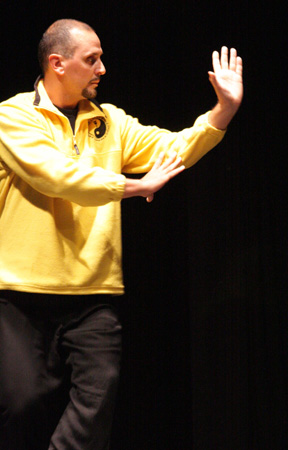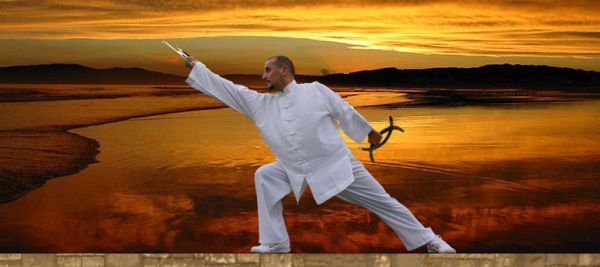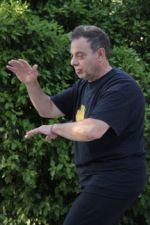
The origin of the term ‘Internal’ with respect to the various Chinese Internal Arts is a subject of great debate. Generally the term ‘Neijia’ relates to ‘internal’ styles of martial arts, which relates to a system of ‘internal’ power as opposed to simply applying ‘external’ power of muscular force.
Internal power can be achieved by establishing a good postural position, a sense of ‘ground’ connection in conjunction with a clear sense of focus or intent when emitting ‘energy’.
The practice of internal styles of Chinese martial arts such as Taijiquan, Xingyiquan, Baguazhang, Bajiquan, Yiquan, Liuhebafa along with most Qigong practices work to develop the internal energetic system or Qi (Chi) flow through the meridians of the body.
Generally speaking, training these systems starts with exercises to allow the body to move freely and fluidly, also allowing the internal energetic system to flow without impedance. Once the body is relaxed, free and open then the appropriate postures, movements and forms can be learned and practiced in a more effective manner.
Aside from learning the relevant forms there are often ancillary exercises or practices to help develop the energetic system such as Neigong (Internal Energy Work) and Zhuan Zhang (Standing Postures) where the practitioner merely stands still, often with the arms and palms open, to create an open vessel for the energetic system to go where it needs to, in its most natural, free-flowing manner.
The main pages of Taiji Forum looks at the more popular practices just as Taijiquan and Qigong and these pages will look in detail at the other internal arts as mentioned above. Below is a brief description of the other Chinese Internal Arts.
Baguazhang
A martial arts system based on the ‘bagua’ 8-trigam system which, as in the I-Ching (a Chinese system of divination), represents the 8 cardinal directions and energetic powers as are trained and applied during the practice of the art.
The originator of this art Dong Haichuan is said to have learned from Taoist monks during his studies in the holy mountains. Lern more about Baguazhang…
Introduction to the three Baguazhang Seminars
Breathing using specific postures connects body and intention, increases flexibility and resilience, adds quality to our daily routines. Especially useful for health and body care. Continue reading
Walking the Circle – How this simple and very rich tool can change our muscles, tendons, essence and mind. Walking is an art itself and can bring every practice to a higher level. Continue reading
Bagua and the 8 Extraordinary Vessels – Theory and practice of the Micro and Macro Cosmic Breathing applied practically to produce body connection and health. Continue reading
Xingyiquan
Xingyiquan or ‘Form/Intention Boxing is characterized by its straight, linear, sharp movements and explosive strikes.
Although the origin of Xingyi is sketchy it is generally credited to a famous Chinese general, Yue Fei who lived in the Song Dynasty (960 – 1279).
Yiquan
Yiquan, also referred to as Dachengquan was created by Wang Xiangzhai in the 1920s after studying a number of martial arts styles. Yiquan (Mind or Intent Boxing) uses a range of practices designed to unify the body and mind to develop whole body strength, these include: Zhan Zhuang (Standing Postures), Shi Li (Strength Testing), Fa Li (Power Releasing) Tui Shou (Push Hands) Ji Ji Fa (Combat Training), Shi Sheng (Voice/Breath Testing) and Mo Ca Bu (Friction Stepping).
 Liuhebafa
Liuhebafa
Chen Tuan, a famous Taoist who lived in the holy mountain of Hua Shan is said to be the creator of Liuhebafa (Six Harmonies and Eight Methods). Containing the fluidity of Taijiquan, the power-release of Xingyiquan and the deft footwork of Baguazhang Liuhebafa involves the following aspects of training), (Luihe) Six Harmonies, (8 Methods), Sanpan (3 Divisions), Wuzong (5 Hearts), Jiujie (9 Joints).


